| CPC G06Q 20/4016 (2013.01) [G06F 17/16 (2013.01); G06N 20/00 (2019.01)] | 21 Claims |

|
1. A fraud prevention system comprising:
a third-party client server hosting an online application; and
a fraud prevention server including an electronic processor and a memory, the memory including an online application origination (OAO) service,
wherein, when executing the OAO service, the electronic processor is configured to
receive a training dataset of fraudulent online applications using only electronic devices,
generate, with machine learning, an online application origination (OAO) model of the OAO service based on the training dataset, the OAO model differentiating between behaviors of a normal user and fraudulent behaviors of a nefarious actor that occur during a submission of the online application using a first electronic device, the submission capturing a single session of the online application,
perform feature encoding on one or more categorical variables in a first matrix to generate one or more feature encoded categorical variables, the first matrix including the one or more categorical variables and numerical features, and the one or more feature encoded categorical variables are feature encoded with one or more numerical values of the numerical features,
generate a second matrix including the one or more feature encoded categorical variables,
generate, with the machine learning, a feature encoded OAO model by training the OAO model with the second matrix,
receive behavioral information associated with a second submission of the online application using a second electronic device, the second submission capturing a second single session of the online application, and the behavioral information being captured in parallel to the second submission,
determine a fraud score of the second submission of the online application based on the behavioral information that is received and the feature encoded OAO model, and
control the third-party client server to approve, hold, or deny the second submission of the online application based on the fraud score that is determined, wherein the third-party client server is owned by a first entity, and wherein the fraud prevention server is owned by a second entity that has no association with the first entity, and
wherein the behavioral information includes information from one or more of a group consisting of:
cadence of completing the form,
method of moving through the form,
progression through the form,
field order behavior,
“circle back” behavior,
cadence of user typing,
speed of user typing,
form focus behavior,
window-switching behavior,
detail-checking behavior,
pausing behavior,
dynamics of mouse interaction,
dynamics of touch interactions,
device orientation,
device accelerometer,
form field autocomplete,
copy-paste behavior, and
familiarity with the form.
|